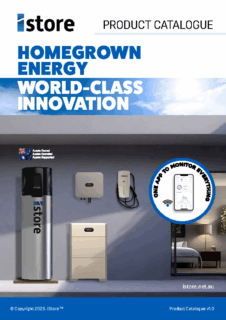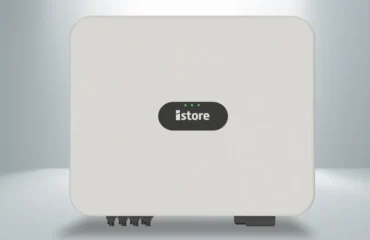
As more households look to cut their energy costs and reduce their reliance on the grid, solar batteries are stepping into the spotlight.
For solar installers, they’re no longer just an optional add-on; they’re becoming a key part of the conversation. And for customers, they’re a way to take control of how and when they use solar power.
Whether you’re an installer explaining battery options or a homeowner weighing up your solar investment, it’s important to understand the answer to the question: “How do solar batteries work?”
Then, you’ll be in a better position to compare products, understand their benefits, and make informed decisions that suit each home’s energy needs and budget.
What Are Solar Batteries, and How Do They Work?
Solar batteries are energy storage systems designed to hold excess electricity generated by solar panels. Instead of sending unused solar power back to the grid, these batteries store it for later use, like at night, during cloudy days, or when there’s a blackout.
How do solar batteries work? Here’s the process.
- Power Generation: During the day, solar panels absorb sunlight and generate direct current (DC) electricity.
- Power Conversion: A hybrid inverter converts that DC electricity into alternating current (AC) power for use in the home. At the same time, it directs any extra energy into the solar battery for storage.
- Power When Needed: When the sun goes down or a home’s energy use spikes, the house automatically draws power from the battery first, reducing the need to buy electricity from the grid.
Solar Inverters: A Solar System’s Traffic Controller
A solar inverter plays a crucial behind-the-scenes role in any solar and battery setup. It manages the flow of electricity between the solar panels, the battery, and the home’s appliances.
First, it converts the electricity coming from the panels (which is in DC form) into AC electricity, which is what most appliances run on.
If there’s more solar energy than the household needs at that moment, the inverter sends the excess power to the battery for storage. Later, when energy is needed and the sun is not shining, the inverter sends stored power from the battery to the home.
A solar inverter constantly switches between sources, making decisions in real-time about where electricity should go. Without it, a solar battery system wouldn’t be able to function properly.
Types of Solar Batteries and How They Function
| Battery Type | What It Is | How It Works | Pros | Cons |
| Lithium-Ion | The most common battery type for home solar systems | Uses lithium compounds to store and release energy through chemical reactions | High efficiency, long lifespan, compact size, fast charging | Higher upfront cost |
| Lithium Iron Phosphate (LiFePO₄) | A subtype of lithium-ion, known for thermal stability and safety | Similar to standard lithium-ion but uses iron phosphate for better stability and longevity | Safer, longer cycle life, resistant to overheating. The preferred choice for most households. Used at iStore | Slightly bulkier than other lithium batteries due to lower energy density. Only a problem if space is limited or a more compact setup is preferred |
| Lead-Acid (Flooded and AGM) | Traditional battery type, often used in off-grid systems | Stores energy using lead plates and a liquid or gel electrolyte | Lower upfront cost, widely available, simple tech | Shorter lifespan, lower efficiency, bulky, requires ventilation or maintenance (flooded) |
| Flow Batteries | Emerging tech, mostly used in commercial settings for now | Stores energy in external tanks using liquid electrolytes that flow through a cell | Very long lifespan, scalable capacity, easy to recycle | Expensive, large physical footprint, not yet widely used in homes |
| Saltwater | Newer, eco-friendly battery option | Stores energy using saltwater electrolytes rather than heavy metals | Non-toxic, recyclable, no risk of fire or overheating | Larger size, lower availability, lower energy density |
Key Benefits of Solar Batteries for Homeowners
If you’re an installer trying to convince your clients they need a solar battery, or you’re a homeowner investigating whether it’s worth getting one, here are the benefits to consider.
- Energy Independence: Reduces reliance on the grid by storing excess solar power for later use, especially during peak times when electricity prices are higher or when outages occur.
- Lower Electricity Bills: Helps cut power costs by using stored solar energy instead of buying electricity from the grid.
- Backup Power: Keeps essential appliances running during blackouts or grid failures, for peace of mind.
- Environmental Impact: Makes better use of clean, renewable energy and reduces overall carbon footprint.
- Scalability: Allows homeowners to start small and expand their battery storage as their energy needs grow or budgets allow, e.g. installing more solar panels or buying an electric vehicle.
The Solar Battery Charging and Discharging Process
During the day, when solar panels generate more electricity than the home needs, the excess energy is sent to the battery. This is known as charging. The battery stores this energy instead of it being sent back to the grid.
At night, on cloudy days, or during power outages, the battery discharges, supplying that stored energy to keep appliances and lights running. The home automatically draws power from the battery first before turning to the grid.
An important factor in this process is the Depth of Discharge (DoD), which refers to the percentage of the battery’s stored energy that can be used before it needs to be recharged. For example, a battery with a 90% DoD can safely use up to 90% of its capacity each cycle.
A higher DoD means more of the battery’s stored energy can be used each day. However, discharging too much too often can reduce the battery’s lifespan. It’s about finding the right balance between daily use and long-term durability.
Factors That Affect Solar Battery Performance
- Battery Type: Different battery chemistries, such as lithium-ion, lithium iron phosphate, or lead-acid, offer varying levels of efficiency, lifespan, and storage capacity. At iStore, we use lithium iron phosphate (LiFePO₄) batteries, as they tend to last the longest, with more charge cycles than standard lithium-ion or lead-acid batteries.
- Temperature: Extreme heat or cold can impact battery performance and longevity, especially if the system isn’t installed in a temperature-controlled space.
- Usage Patterns: Frequent deep discharges or irregular charging can wear out the battery more quickly, while consistent, moderate use supports a longer lifespan.
- System Integration: Performance improves when batteries are paired with compatible inverters, proper wiring, and smart monitoring tools (like the iStore WLAN dongle) that manage energy flow efficiently.
Why Choose iStore Solar Batteries?
With over 500 solar battery models from 86 manufacturers currently approved for installation in Australia by the Clean Energy Council (CEC), the market offers a wide range of choices.
What makes iStore solar batteries a trusted option for homes across the country?
- Durability in Australian Conditions: Built to handle Australia’s harsh climate, from scorching summers to cool winters, without compromising performance. Our batteries can operate reliably in temperatures from -20°C to 55°C and have an IP rating of 66 for protection against dust, dirt, and heavy rain.
- Safety Features: Four layers of built-in protections against overheating, overcharging, and short circuits.
- Modular Design: Easily expandable. Each iStore battery is a stackable module weighing 50 kg, with a capacity of 5 kWh (kilowatt-hours). You can connect up to six modules to increase storage to a maximum capacity of 30 kWh.
- More Usable Energy: Delivers 100% Depth of Discharge (DoD). The full capacity of the battery can be utilised without compromising its lifespan, resulting in greater value from every charge.
- User-Friendly Monitoring: Comes with an intuitive app that displays real-time performance, battery levels, and energy usage at a glance.
- Strong Warranty: Our batteries come with a 10-year performance warranty, guaranteeing reliable storage and consistent performance for years to come. This warranty shows that we stand behind our technology and know it can go the distance in Aussie conditions.
FAQs
How Do Batteries Work With Solar Panels?
Solar panels generate electricity during the day and power the home first. If there’s extra energy, the system sends it to the battery for storage. When the sun goes down or energy demand rises, the battery releases the stored power to keep appliances and lights running.
A hybrid inverter actively manages the flow between the panels, battery, and home to make sure everything works smoothly.
How Do Solar Batteries Work in Australia?
Solar batteries store excess solar energy generated by rooftop solar panels during Australia’s renowned sunny days and supply that power when the sun isn’t shining.
Our long sunny days, extreme summer heat, and occasional blackouts from storms make solar batteries particularly useful here.
How Long Will a 10 kW Battery Last?
A 10 kW battery can typically power an average home for 8–12 hours, depending on energy usage. It may last longer if used only for essential appliances, and shorter if multiple high-energy appliances are running simultaneously.
What Happens to Solar Power When Batteries Are Full?
When a solar battery is fully charged, any excess solar power is sent back to the grid or, in some systems, redirected to power non-essential appliances. This process prevents energy from going to waste while keeping the battery protected from overcharging.
Do Solar Batteries Recharge Themselves?
No, solar batteries don’t recharge themselves. They rely on excess electricity generated by solar panels during the day to charge. Without solar input or grid charging (if supported), the battery won’t refill.
Maximise Your Energy Independence with iStore Solar Batteries
How do solar batteries work?
Think of them as a home’s personal power bank, quietly saving up the extra solar energy collected during the day so it’s ready to use when the sun isn’t out. For powering appliances after dark, keeping the lights on during a blackout, or cutting down energy bills, a solar battery gives solar power a second life.
In a world where energy costs keep rising and sustainability matters more than ever, solar batteries are becoming an integral part of building smarter, more efficient homes.
That’s why iStore is committed to delivering solar battery solutions built for Australian homes. Our systems are durable enough to handle local conditions, efficient enough to make a real difference, and packed with safety features for added confidence.
Browse our solar battery and solar inverter range today, then get in touch for a consultation or quote by calling 1300 515 640 or filling out this online form.




